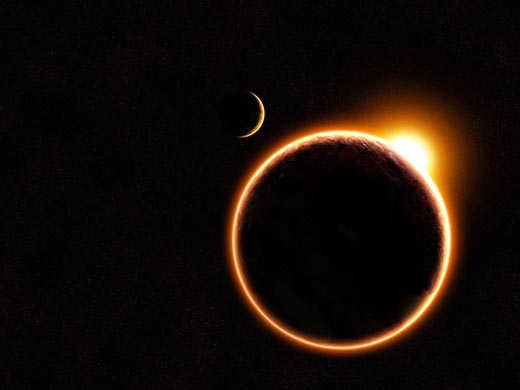A total solar eclipse is a remarkable event in nature that occurs when the Moon completely or partially obscures the Sun for an observer on Earth. This phenomenon can be classified into two types: total and partial eclipses. In this article, we will explore when the next solar eclipse will take place in Russia in 2023.
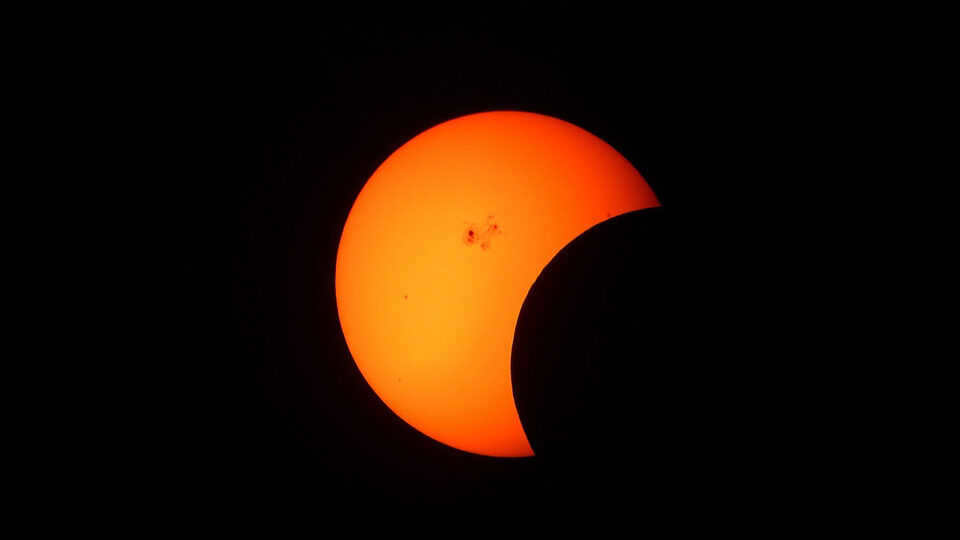
When solar eclipses occur, the surroundings become dimmer, and during a total eclipse, complete darkness ensues. This celestial event has been documented in various ancient sources, including Chinese and Russian chronicles. In fact, historians rely on references to eclipses in manuscripts to establish the sequence of certain historical events. In the year 2023, we are anticipating the occurrence of two solar eclipses.
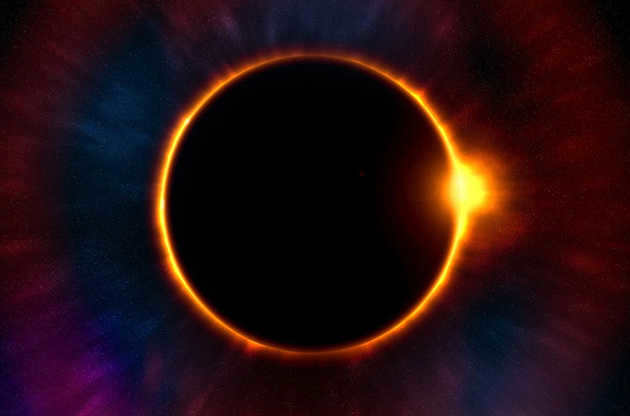

What is the impact of solar eclipses?
Solar eclipses leave a lasting impact on the inhabitants of Earth. Animals become restless, birds become silent and find refuge in their nests.
Humans also respond to this celestial event. The eclipse, for reasons that are not yet fully understood, affects the human psyche: it increases anxiety and nervousness. Women are believed to be particularly affected, experiencing feelings of discomfort and weakness. During a solar eclipse, 70% of the population experiences an increase in blood pressure and heart rate.
What you should be aware of if you plan to witness the solar eclipse
Under no circumstances should you directly observe the eclipse with your naked eyes!
Doing so can result in severe visual impairment. Wearing sunglasses will not provide any protection. If you wish to safely view the eclipse, it is recommended to purchase a solar filter film in advance from reputable online retailers (which is cost-effective). Alternatively, you can consider using a welder’s mask with a tinted glass level of at least 14 (available for purchase at construction stores). As a last resort, you can create a makeshift filter by darkening one side of a glass shard completely, without any gaps or scratches, over a candle flame. However, it is important to note that viewing through this filter for prolonged periods is not advisable.
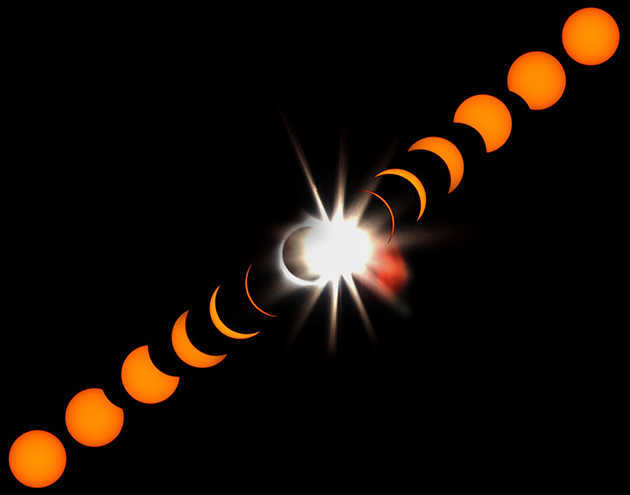
Make sure to closely supervise your children!
Children may not fully understand the potential danger to their eyes from observing a solar eclipse. They may inadvertently harm their vision by attempting to view the sun through binoculars, even for just a brief moment.
Expert opinion
According to Valentin Kozheshkurt, a senior methodologist at the Internet Lesson Home School in physics and math:
– Solar eclipses occur when the Moon aligns with the Earth and the Sun, creating a shadow on the Earth. For those within the shadow, the Sun appears to be partially or completely blocked by the Moon.
The Moon does not follow a perfectly circular path around the Earth, but instead moves in an elliptical orbit. As a result, the distance between the Moon and the Earth can vary, causing the Moon to appear slightly larger or smaller at different times. When the Moon’s angular size is smaller than that of the Sun, it does not completely block out the Sun, leaving a small ring of sunlight visible. This type of eclipse is known as an annular eclipse.
Lydia Fedorova, Western astrology specialist with 5 years of professional experience:
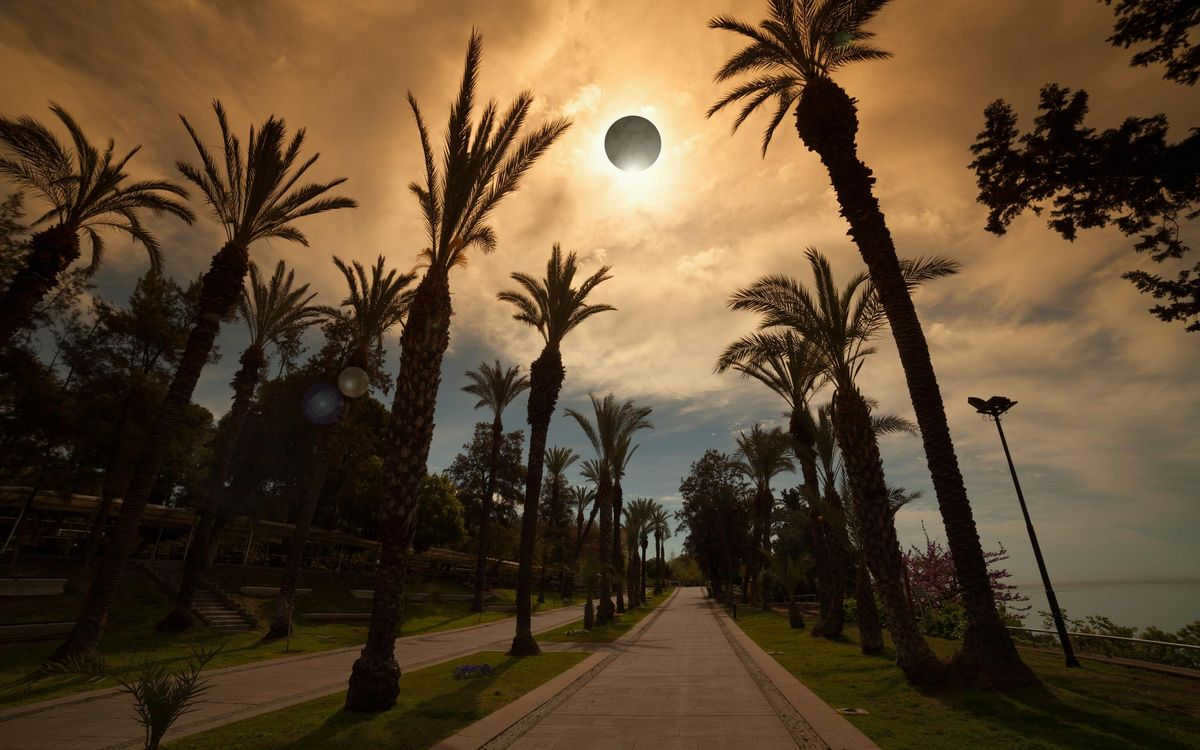
In previous times, individuals held the belief that the “black sun” was a harbinger of disasters. Much has changed since then, but even in the present day, solar eclipses continue to captivate our fascination. We provide you with information on where to witness these celestial events in 2023 and offer tips on how to maximize your viewing experience.
Understanding solar eclipses
A solar eclipse is a natural occurrence in which the Moon becomes visible from Earth as it completely obscures the Sun. Positioned between the Earth and the Sun, the Moon casts a shadow upon the Earth, resulting in the phenomenon we observe as a solar eclipse.


From Earth, it appears that the Moon is gradually obscuring the Sun, making it seem like a dark spot is covering the luminary. (Photo: Shutterstock)
Solar eclipses occur only during the new moon phase – a brief period when the Moon aligns in a straight line between the Earth and the Sun. The Moon is not visible in the sky during this time.
A new moon happens approximately once a month, resulting in 12 new moons in a year. Within a year, there can be two to five solar eclipses. The last time there were five solar eclipses was in 1935, and this won’t occur again until 2206.
Solar eclipses have been a subject of observation by people since ancient times. According to archaeological findings, as far back as 3,000 years ago, priests with expertise in astronomy were able to forecast eclipses [1]. Additionally, civilizations that possessed a written language documented solar and lunar eclipses in their historical records, recognizing a correlation between these celestial events and significant historical occurrences. Thanks to these well-preserved records, we are now able to determine the dates of such events and make comparisons between ancient chronology systems and the modern calendar.
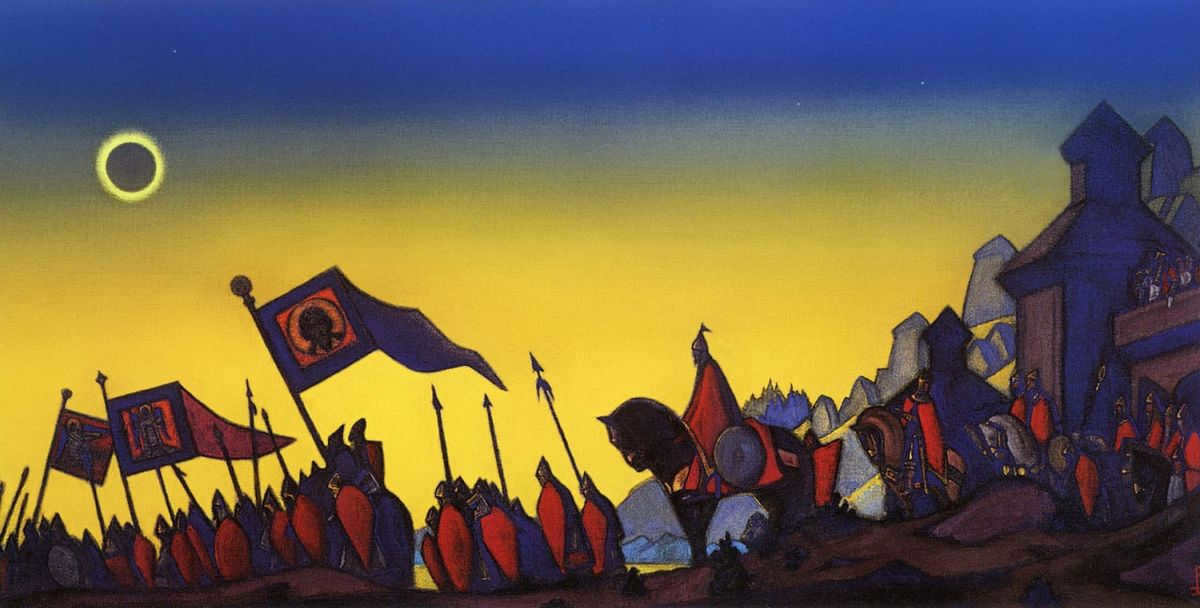

The epic poem “The Tale of Igor’s Campaign” references the solar eclipse that took place on May 1, 1185. Prince Igor saw it as a warning of forthcoming difficulties. He and his entourage were en route to the Cumans’ lands during the eclipse and could only observe a partial obscuration of the sun. Nikolai Roerich’s painting “Igor’s Campaign” from 1942 captures this moment. (Photo: sibro.ru)
Categories of solar eclipse
Solar eclipses are not observable across the entire expanse of the Earth. On the half of the Earth that is not illuminated by the Sun, it will be nighttime during the eclipse, rendering it invisible to people. However, even on the illuminated side, not everyone will have the opportunity to witness the eclipse. It will only be clearly visible to those within the shadow cast by the Moon. Beyond this shadow, the regular solar disk will be visible and there will be no eclipse.
Individuals within the Moon’s shadow may sometimes experience two distinct perspectives of the same eclipse.
Solar Eclipse Overview
During a solar eclipse, the moon casts its shadow onto Earth, creating two distinct areas:
- The cone or umbra, where the moon’s shadow completely blocks out the sun [2],
- The penumbra region, where the sun is only partially obscured by the moon.
Observers positioned inside the cone will witness a total solar eclipse, with the sun’s disk completely covered [3]. Those located within the penumbra will experience a partial eclipse.
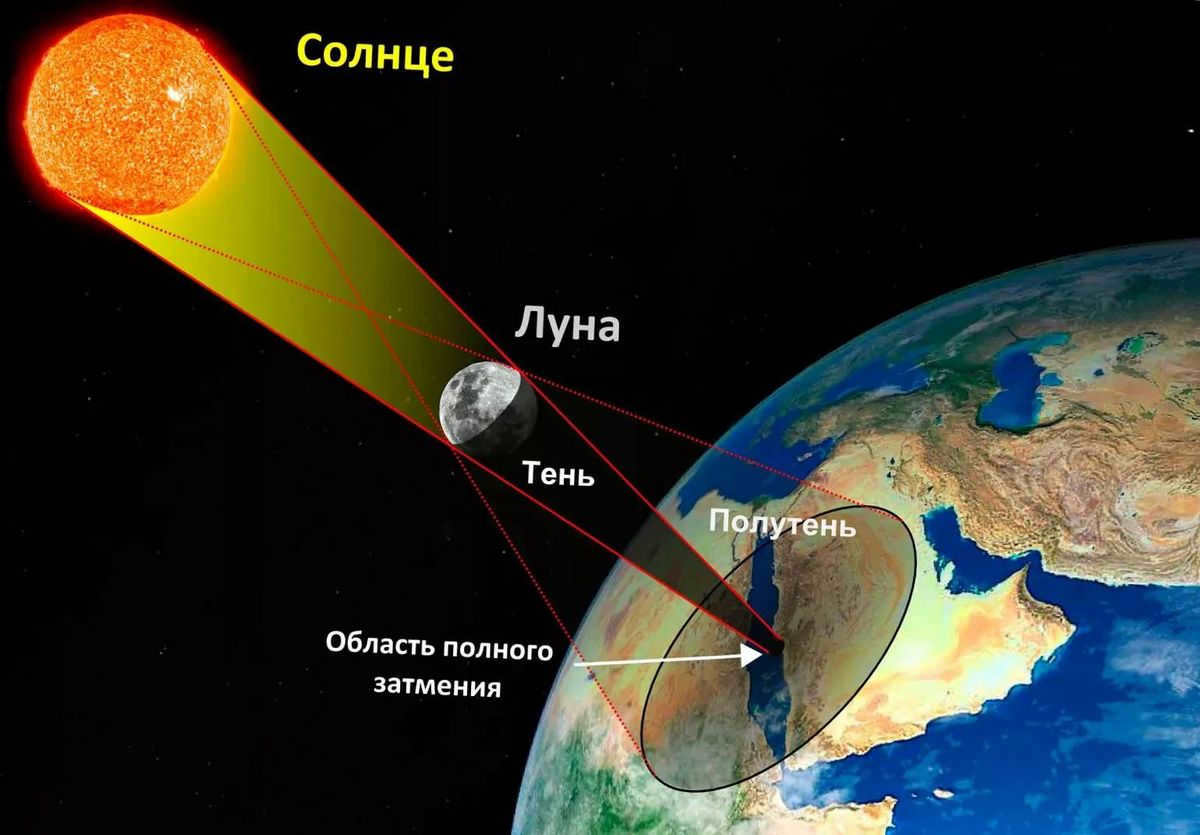

A complete solar eclipse can only be seen in certain parts of the world: usually the portion of the Earth where the “cone” falls is very limited. (Photo: ppt-online.org)
During an eclipse, there are instances where the Moon crosses the Sun’s disk. However, the Moon is smaller in size compared to the Sun, so it is unable to completely block it. In this scenario, the observer will witness an annular eclipse. Instead of seeing a fully covered solar disk like in a total eclipse, they will see a radiant ring surrounding a dark circle [4].
A partial solar eclipse
Sometimes, the Earth is fortunate enough to witness a partial solar eclipse, where the moon’s shadow doesn’t directly hit our planet. This means that no matter where an observer is located on Earth, they will not experience a total eclipse. Instead, they will witness a partial eclipse, often referred to as a private eclipse. During this event, only a portion of the Sun’s disk is covered by the moon’s shadow.
Unlike a total eclipse, a partial eclipse can be observed from a larger area known as the penumbra zone. This means that more people have the opportunity to witness this type of eclipse, as the penumbra zone is larger than the cone of the moon’s shadow.
![Most of the solar eclipses we observe are private. Total solar eclipses occur on Earth on average once every year and a half, and in the same place on Earth once every 300 years [5].](/wp-content/uploads/images/polnoe-solnechnoe-zatmenie-kak-chasto_39.jpg)
![The majority of the solar eclipses that we witness are not total. On average, a total solar eclipse takes place on Earth once every year and a half, and in the same location on Earth once every 300 years [5].](/wp-content/uploads/images/polnoe-solnechnoe-zatmenie-kak-chasto_39.jpg)
The majority of the solar eclipses that we observe are not complete. On average, a total solar eclipse occurs on Earth approximately once every year and a half, and in the same geographical area on Earth once every 300 years [5]. (Photo: planetarium-moscow.ru)
Reasons Behind the Occurrence of Solar Eclipses
The occurrence of solar eclipses, just like other types of eclipses, would have a different appearance if the celestial bodies were positioned differently in space. The distance between the Earth and the Sun is roughly 400 times greater than the distance between the Earth and the Moon, and the Sun’s diameter is approximately 400 times larger than the Moon’s diameter [6]. Consequently, when observed from Earth, the visible disks of the Sun and the Moon appear to be nearly identical. This remarkable coincidence is what allows for the occurrence of total solar eclipses.
However, this situation will not persist indefinitely. Over time, the Moon has been gradually moving away from the Earth at a rate of about 3-4 centimeters per year. If this movement continues at a consistent pace, then in 600 million years solar eclipses will cease to exist completely: the comparatively small Moon in the sky will no longer be capable of completely blocking out the solar disk.
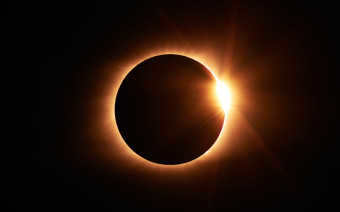
Solar eclipses in 2023
Detailed information about the visibility conditions of solar and lunar eclipses can be found in astronomical yearbooks and on the NASA website [7]. For instance, the astronomical yearbook published by the Institute of Applied Astronomy of the Russian Academy of Sciences provides an online schedule of all lunar and solar eclipses since 1999 [8]. In the year 2023, there will be two solar eclipses:
- On April 20, 2023, there will be an annular total solar eclipse. It will be visible in the eastern Indian Ocean, as well as in Australia and the islands of the western Pacific.
- On October 14, 2023, there will be an annular solar eclipse. It can be observed by residents of Central and South America. However, it will not be visible from Russia.
People living in countries where they won’t be able to witness the eclipse in person can still enjoy it online: NASA frequently hosts live video broadcasts of lunar and solar eclipses. Additionally, several prominent media organizations that operate within the vicinity of the eclipse also provide live coverage, including The Weather Channel and CNN.
The total solar eclipse that occurred on August 21, 2017 was visible from the United States and was streamed live by The Weather Channel in the US.
Tips for Safely Observing a Solar Eclipse
Many people find solar eclipses to be a fascinating astronomical event that is incredibly exciting to witness in person. However, it is important to remember that observing a solar eclipse without proper eye protection can be extremely dangerous.
Alexander Kuskov, an ophthalmologist at the Eye Microsurgery Center “I See” in St. Petersburg, explains the potential risks involved: “During childhood, many of us may have played around with a magnifying glass and experienced how easy it is to start a fire on a sunny day. In the eye, the lens and cornea act as a similar magnifying lens. The sun’s rays during an eclipse are powerful enough to focus and cause burns to the macula, which is the central part of the retina. This condition is known as ‘solar maculopathy’ or light-induced damage to the retina.”


Reversible and irreversible changes in vision, such as the development of a dark spot in the central field of vision, known as central scotoma, can occur depending on the length of time one is exposed to sunlight. This phenomenon is referred to as central scotoma in medical terminology. (Photo: lang-eng.wellforlifenow.com).
According to Olga Konikova, an ophthalmologist at Lahta Clinic, it is necessary to use filters that block a significant portion of the light flux in order to safely observe a solar eclipse in person. Such filters may include:
- There are special glasses available for observing the eclipse, which can be purchased from online stores.
- An alternative option is to use a welding mask.
- Another option for eye protection is using amateur versions such as candle-smoked glass.
When using the latter option, it is important to ensure that the filter is completely black. Filters that are only slightly darkened will not provide sufficient protection from sunlight. It is crucial to avoid observing a solar eclipse through regular sunglasses or by stacking multiple glasses on top of each other.
Failure to follow these precautions can result in damage to the retina, especially for individuals with pre-existing vision issues. While these changes are typically reversible, approximately 10% of cases may experience long-term vision reduction.
A cup of tea in hand, Ophthalmologist Alexander Kuskov maintains that the most secure method to witness the eclipse is through the screen of a phone or computer, comfortably seated at home.

Outer Space
Witnessing a solar eclipse is an incredibly captivating event that any individual with even a remote fascination with outer space would eagerly seize the opportunity to observe. This occurrence, where the sun is entirely concealed by the shadow, is infrequent, making it crucial to plan ahead in order to not miss out on the moment. Scientists who study celestial bodies are acutely aware of the predictable nature of solar eclipses and their distinct characteristics. Numerous fascinating details about these phenomena have already been discovered.
To start, it is important to comprehend the concept of a solar eclipse. This occurrence happens when the moon’s shadow covers the Earth, causing sunlight to be completely blocked from reaching the surface. During this time, the moon is positioned between the sun and the planet.

Did you know? The moon’s shadow has a diameter of approximately 200 kilometers. Meanwhile, the moon itself has a diameter of 3,474.2 kilometers.
When observing a solar eclipse from Earth, you can witness the moon completely obscuring the sun. It’s important to note that this phenomenon is only possible due to a fortunate coincidence. The moon’s diameter is 400 times smaller than that of the sun, but it is also 400 times closer to Earth than the sun. This difference in size is compensated for, allowing the moon to cast a shadow on the sun during an eclipse. If the sizes or distances of either body were different, the phenomenon would appear significantly altered.
A solar eclipse happens when the new moon takes place. At this time, the moon is not visible from the Earth because no light from the star reaches the side that faces the planet. As the Moon starts to gradually block the light from the Sun, it appears as if the Sun is slowly being covered by a dark spot.
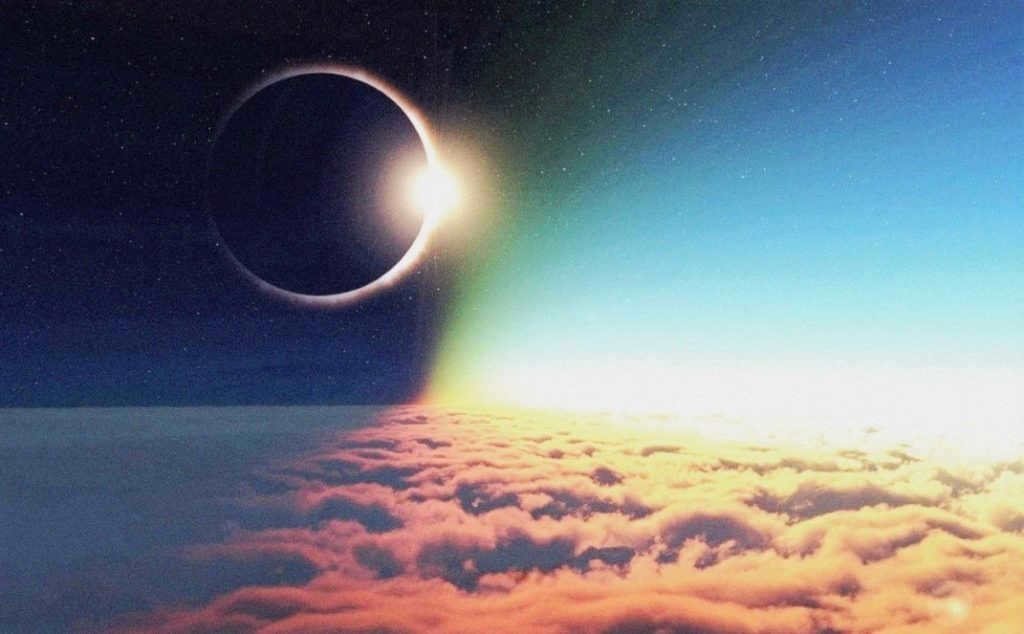
When the Moon passes between the Sun and the Earth, it creates a shadow that falls on the Earth. Due to the distance, the shadow is not a precise point but a larger area. As the Moon orbits, the eclipse lasts for a maximum of 2 hours, with the Sun being completely covered for no more than seven minutes. Throughout this process, the shadow moves across the planet at a speed of 1 km/s.
A solar eclipse happens no more than twice a year and each time it must be observed from a different location on Earth. For example, in 1986, it could be seen from the Atlantic Ocean and lasted only a second. Thirty years prior to that, the people of the Philippine Islands witnessed the eclipse, which lasted a little over seven minutes.

Scientists speculate that over time, the solar eclipse will become undetectable to Earth’s inhabitants. This phenomenon is attributed to the gradual movement of the Moon away from our planet. According to calculations, in approximately 600 million years, the Moon will have traveled far enough to no longer cast a shadow on the planet’s surface.
When witnessing a solar eclipse, it is crucial to utilize specialized protective equipment. Despite the dimming of the Sun’s brightness when obscured by the Moon, direct observation can still cause severe damage to the eyes. Failing to employ protective eyewear, such as glasses, can result in harm to the retina.
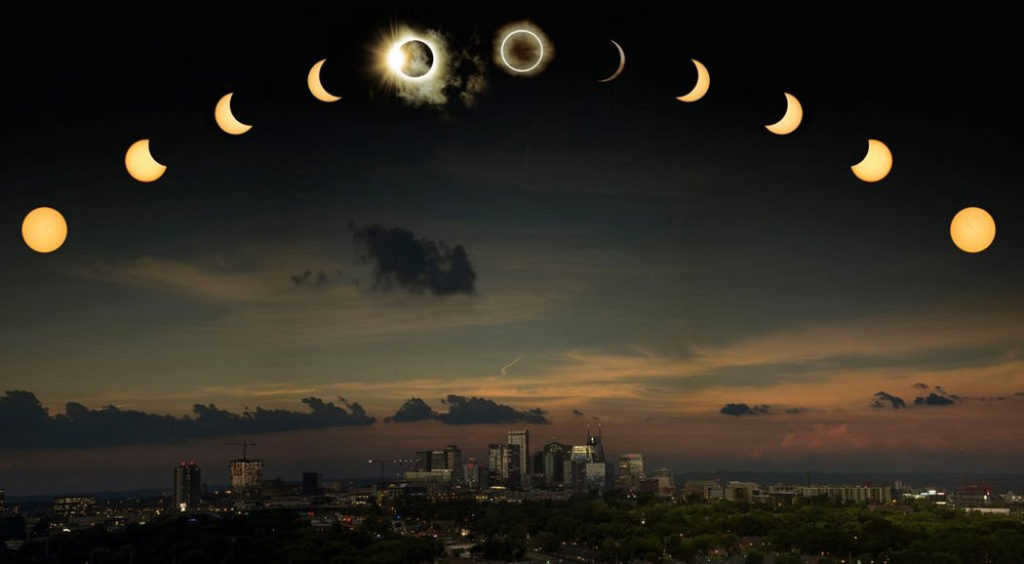
What causes a solar eclipse
A solar eclipse can be observed by people who find themselves in the path of the moon’s shadow. If you carefully observe the Sun during this phenomenon, you will see how it gradually becomes covered by the moon. However, in order to have a guaranteed viewing experience, it is important to have clear weather conditions without excessive cloud cover.
Fascinating fact: When the eclipse reaches its peak, the temperature on Earth under the moon’s shadow drops by approximately 5 degrees Celsius.
Once the Moon completely obscures the Sun, the Earth’s surface is enveloped in darkness. In clear conditions, even the stars that are typically concealed during the day can be spotted. Eventually, the star begins to emerge on the opposite side, and as the Moon progresses, it transforms from a crescent shape back into a full circle.
It is not necessary to be directly beneath the Moon’s shadow to witness the eclipse. The Moon also casts a penumbra, which spans approximately 7,000 kilometers in diameter. However, individuals in this region will only observe the phenomenon from an angle, meaning the Sun will not be entirely concealed by the Moon throughout the event.
Various Kinds of Solar Eclipses
There are three distinct categories of solar eclipses that scientists recognize. These categories are distinguished by the path that the moon takes as it moves across the sky, the relative size of the moon compared to the sun, and other factors that come into play during the event.
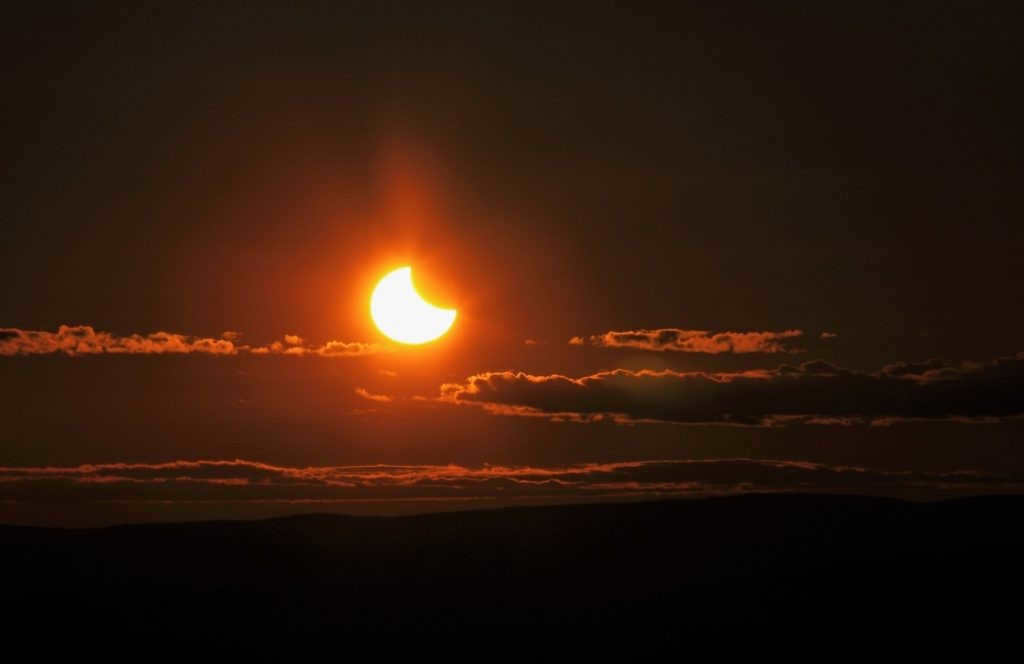
An occurrence of this phenomenon takes place when the path of the Moon does not intersect with the center of the Sun. Under such circumstances, the Moon does not completely obscure the Sun, allowing a portion of it to remain visible.
Fascinating fact: partial eclipses are the most prevalent and make up over 70% of the total number.
The sum of all

During a total solar eclipse, the Moon’s path intersects with the Sun’s center. The Moon’s apparent size from Earth should be larger than that of the Sun, causing the Sun to be completely covered. This type of eclipse is extremely rare, and to witness it, one must be within the Moon’s shadow, which has a diameter of approximately 250 kilometers.
Did you know? The last time a total solar eclipse was visible in Moscow was on August 19, 1887. Based on early predictions, the next one will occur in 2126.
Annular
Annular means having the shape of a ring or circular.
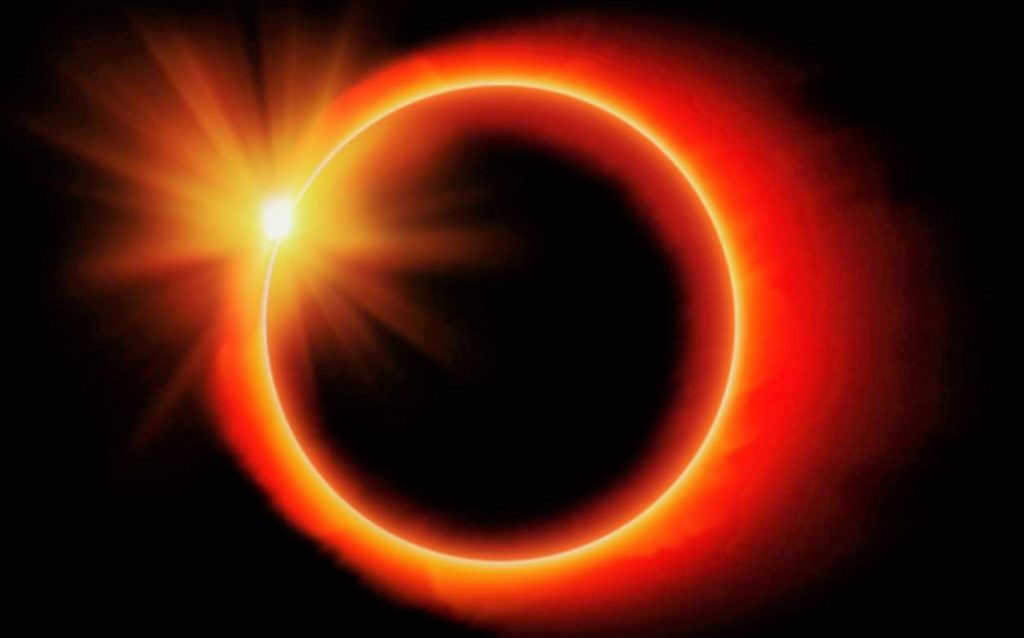
An annular solar eclipse occurs when the path of the Moon intersects with the center of the Sun, but the Moon appears slightly smaller than the Sun, creating a bright ring of light around the edges. This type of eclipse is considered rare, accounting for only 5% of all eclipses.
Hybrid
The text “Hybrid” cannot be paraphrased while preserving the HTML markup as it is a single word and does not have a specific meaning that can be paraphrased.

A hybrid eclipse occurs when the total eclipse transitions into the annular stage, or vice versa. This can happen if, at the time of the event, the Moon is either moving farther away from or closer to the Earth along its orbit. The most recent hybrid eclipse on record took place in 2013.
Irrespective of the specific type of eclipse, when the Earth, Moon, and Sun align, the gravitational force on the planet increases. This can lead to headaches, migraines, and high blood pressure in individuals who are sensitive to changes in weather. Animals also exhibit negative reactions to this phenomenon, often becoming more aggressive in their behavior.
Phenomena observed during a solar eclipse
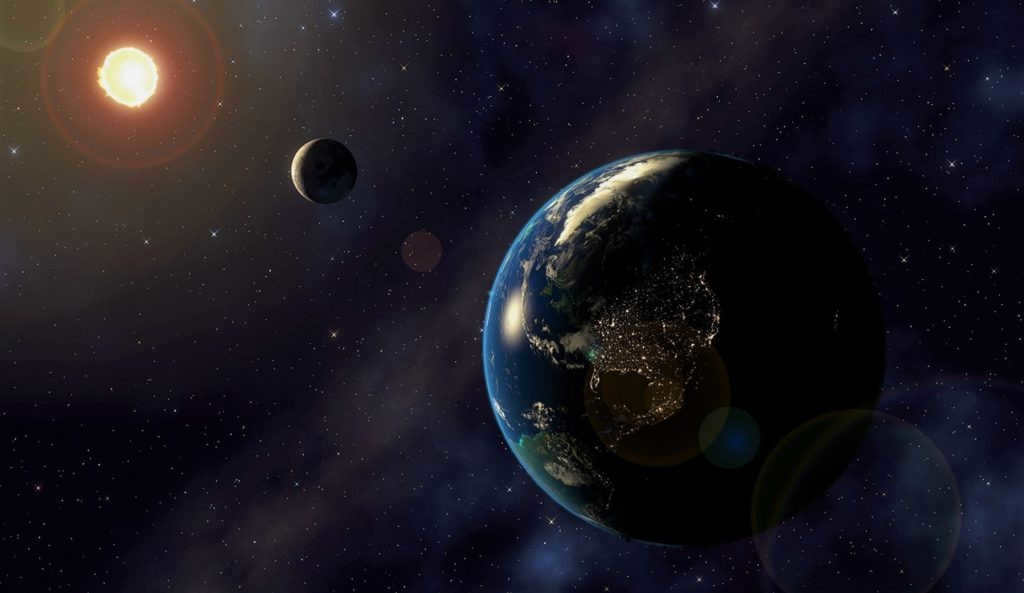

When a solar eclipse occurs, various phenomena occur on Earth. When the planet aligns with the star and the satellite, its gravitational pull significantly increases.
As mentioned previously, this can cause health issues for individuals who are sensitive to changes in atmospheric pressure. Animals may also exhibit unusual behavior during this time. Birds, for example, may stop chirping, potentially sensing the shift in gravity.
Did you know? Shadows cast by objects on the Earth’s surface become significantly longer during a solar eclipse.
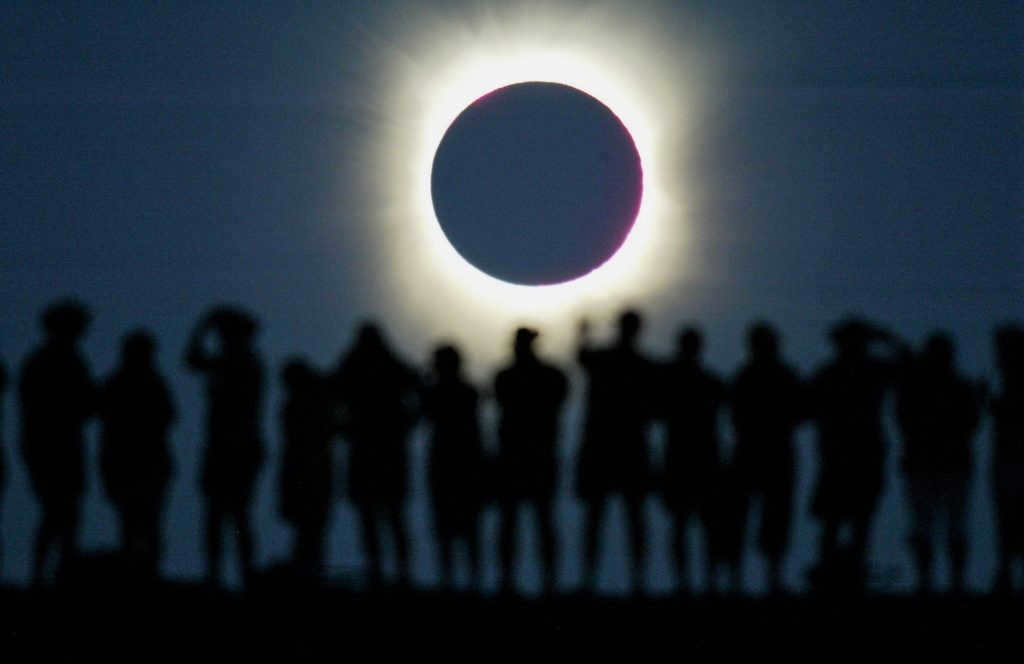
Due to the need to face the Sun during an eclipse, there is a risk of eye damage for individuals who are not trained. To mitigate this risk, it is advisable to observe the phenomenon using specialized equipment. There have long been multiple safe methods for observing a solar eclipse.
Even when the Moon completely covers the Sun, it still emits a significant amount of rays towards Earth. In comparison, the normal brightness of the Moon is only 1% of a star’s brightness during an annular eclipse. This highlights the importance of prioritizing eye safety, especially when using magnifying devices for observation.
In the modern world, there are various ways available to safely observe a solar eclipse without causing harm to your eyes.
Point projection method
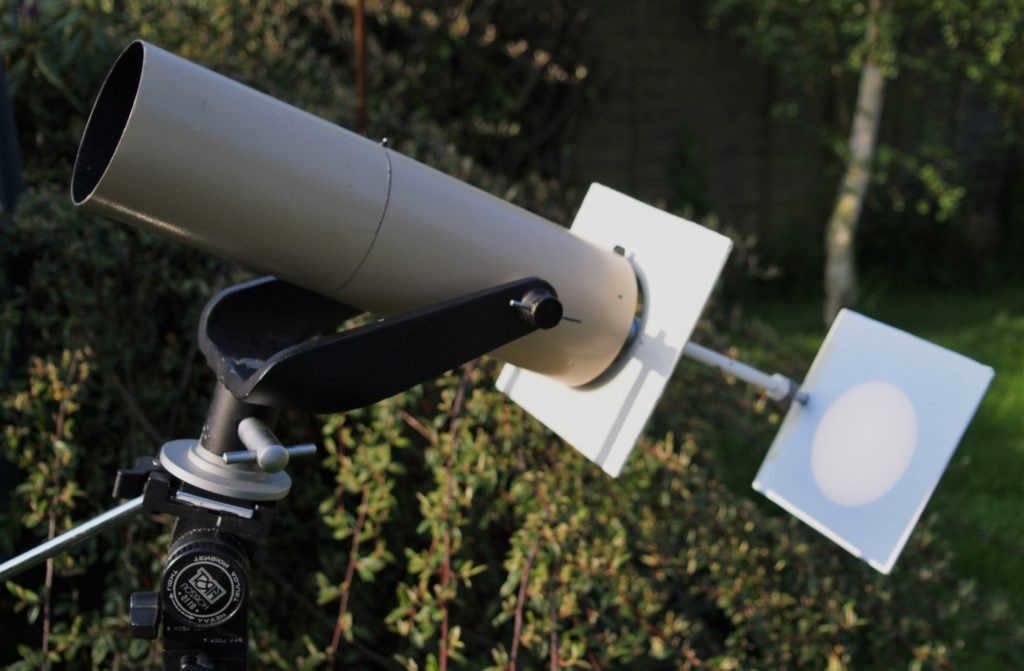
When employing this technique, it is imperative to utilize an improvised camera obscura. Two sturdy cardboards are required, with a hole being made on one of them. Subsequently, it should be positioned on the telescope or any other device that will be utilized for observation. The entire cardboard should be set up in such a manner that the rays of light passing through the telescope fall vertically onto its surface.
Once the framework has been completed, the observation device is carefully directed towards the Sun. As the beams of light filter through the various lenses, a vibrant circle will materialize on the surface of the cardboard, representing an inverted projection of the celestial body. Consequently, when the Moon obscures the radiance of the Sun, individuals can safely witness this phenomenon without causing any harm to their eyes.
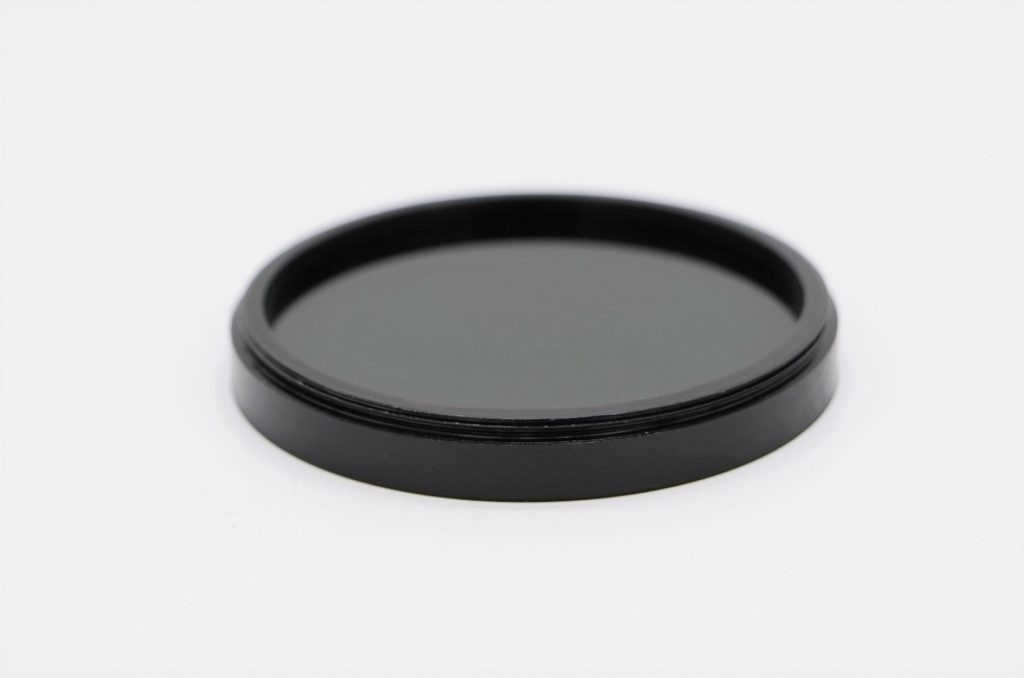
To ensure the safety of your eyes during a solar eclipse, it is recommended to use special light filters made of black and aluminized polyester. These filters are typically incorporated into specialized glasses.
By absorbing the majority of the sun’s rays, the polyester material allows for the observation of the star and its contours. This makes the filters ideal for viewing an eclipse. However, it is crucial to select a model with a material density of at least 5 to prevent the star’s brightness from causing harm to the eyes.
It is important to prioritize safety and not to stare at the Sun for an extended period of time, even when equipped with the appropriate light filter.
Observing the Stars and Planets with a Telescope and Binoculars
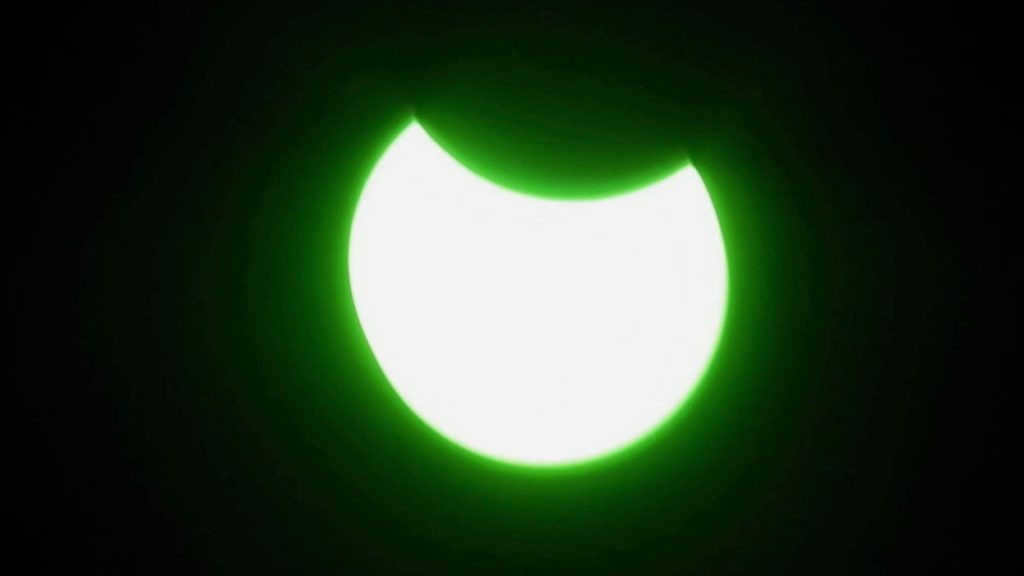
When observing a solar eclipse, it is important to use a telescope or binoculars. It is not recommended to look at the sun directly through magnifying lenses, as this can harm your eyes. Fortunately, there are special light filters available that allow you to safely observe this phenomenon.
Furthermore, certain models of filters can even provide different colored views of the sun. For instance, you can observe the sun in yellow, blue, and other colors. Each filter is designed for specific situations. For example, an orange-tinted filter is ideal for viewing a total eclipse, while a blue-tinted filter is best for observing an annular eclipse.
Breakthroughs Uncovered with the Solar Eclipse
For scientists, an eclipse serves as not just a breathtaking spectacle, but also a golden opportunity to delve deeper into the Sun and expand their understanding of the universe’s composition. During this celestial event, astronomers can meticulously gather data about the star’s corona, a task that is typically unattainable under mundane circumstances. And on occasion, it leads to new revelations.
The initial groundbreaking discovery, brought to light by the solar eclipse, occurred in 1868. The brilliant mind behind this finding was astronomer Pierre Jansen, who successfully observed the Sun’s chromosphere without any hindrance while it concealed itself behind the Moon. This remarkable feat led to the identification of a novel chemical element – helium.
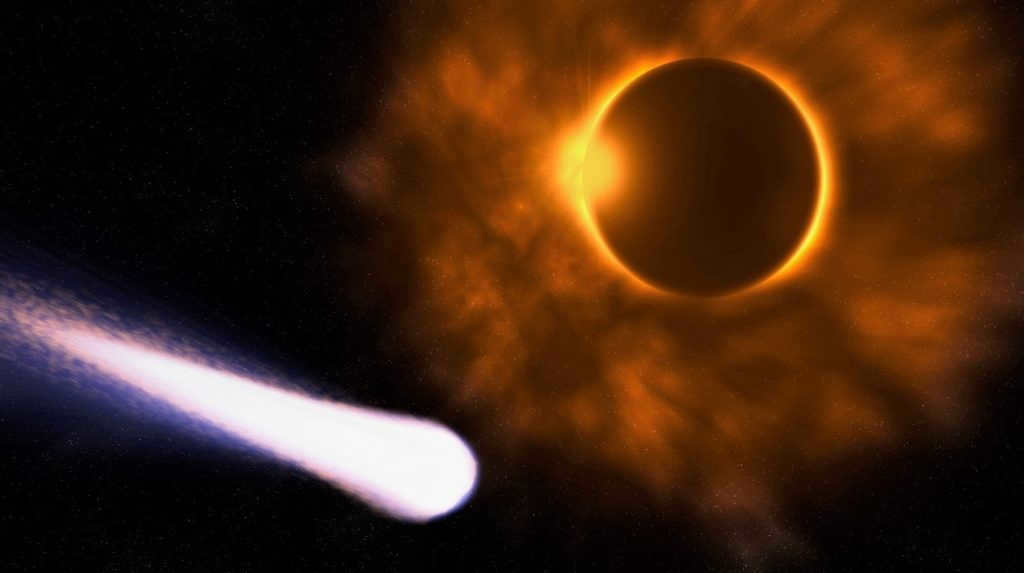
Scientists were able to observe a comet passing close to the Sun during the 1882 eclipse in Egypt. This comet was named “Eclipse Comet” because it was only observed during this phenomenon.
Did you know? A solar eclipse can be observed from the same point on Earth approximately once every 400 years.
Astronomers can predict the movement of objects in the solar system and therefore schedule eclipses for the future. The time, location, and duration of solar eclipses up until the end of the 21st century are already known.
Solar Eclipses in 2020: Dates and Locations
There are two exciting solar eclipses scheduled for the year 2020. To witness the full glory of these celestial events, you must be at specific locations where the moon’s shadow will cast its mystical spell.
The first solar eclipse took place on June 21 and was most prominently visible in Africa and Asia. Residents of CIS countries had the opportunity to witness a partial eclipse. The eclipse began at 6:45 Moscow time and concluded at 12:34, with the maximum eclipse occurring at 9:40.
The second solar eclipse of the year will occur on December 14. The best vantage points for observation are the territories of South America. It is estimated that the eclipse will commence at 16:33 and come to an end at 21:53.
Mark your calendars and get ready to marvel at the wonder of solar eclipses in 2020!
Solar Eclipses in 2021
The first solar eclipse of 2021 is scheduled for June 10 and will be of the annular type. It will be particularly notable for those living in Russia. The peak of the eclipse is expected to occur at 11:26 a.m. and will last approximately 3 minutes and 51 seconds. After that, the Moon will gradually move away from the Sun.
The second eclipse is set to take place on December 4 and will be a total eclipse. It will be visible to residents of Australia and Africa. During this event, the Moon will completely block the Sun for a duration of around 1 minute and 55 seconds.
2022 Solar Eclipses
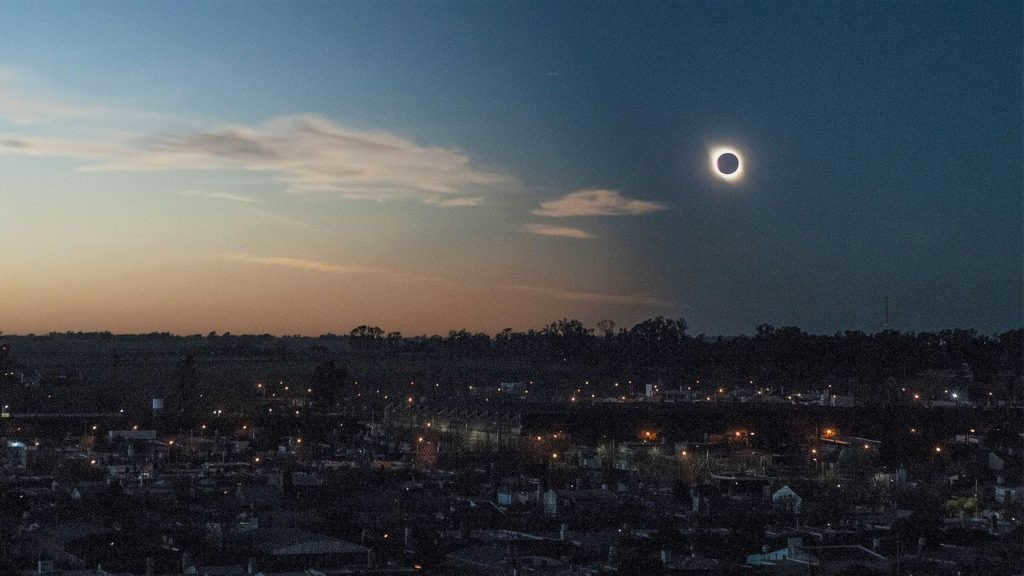

This year will mark the first occurrence of the Sun disappearing behind the Moon on April 30th, around 20:42. The eclipse will be of the partial type, with the Sun being obscured by only 65% by its celestial partner. The ideal location to observe this phenomenon would be in South America.
The subsequent eclipse is scheduled for October 25th, at approximately 11:01 am. This time, it will also be a partial eclipse, with the Sun being concealed by 86%. Observers in Siberia, Europe, Africa, and Asia will have the opportunity to witness this event.
In both cases, astronomers have yet to determine the exact duration of the eclipse, so the Sun may be hidden by the Moon for as short as a minute or as long as seven minutes.
In 2023, the first eclipse is scheduled to occur on April 20th, and it will be a unique type of eclipse known as a hybrid eclipse. This celestial event will offer Earth’s inhabitants a captivating opportunity to witness the Moon’s changing position in relation to the star. However, the spectacle will be relatively brief, with the eclipse’s peak lasting only 1 minute and 16 seconds, starting at 4:17. The phenomenon will be most prominent in Indonesia and Australia.
Fascinating fact: The eclipse shadow will have a width of just 49 kilometers, making it one of the narrowest in the 21st century.
The subsequent eclipse will be an annular eclipse, scheduled to take place on October 14 at 18:00. This event will be most visible in the western United States, Colombia, and Brazil. During a duration of 5 minutes and 17 seconds, observers will have the opportunity to witness the Moon obscuring 95% of the Sun.
Solar eclipses occurring in 2024
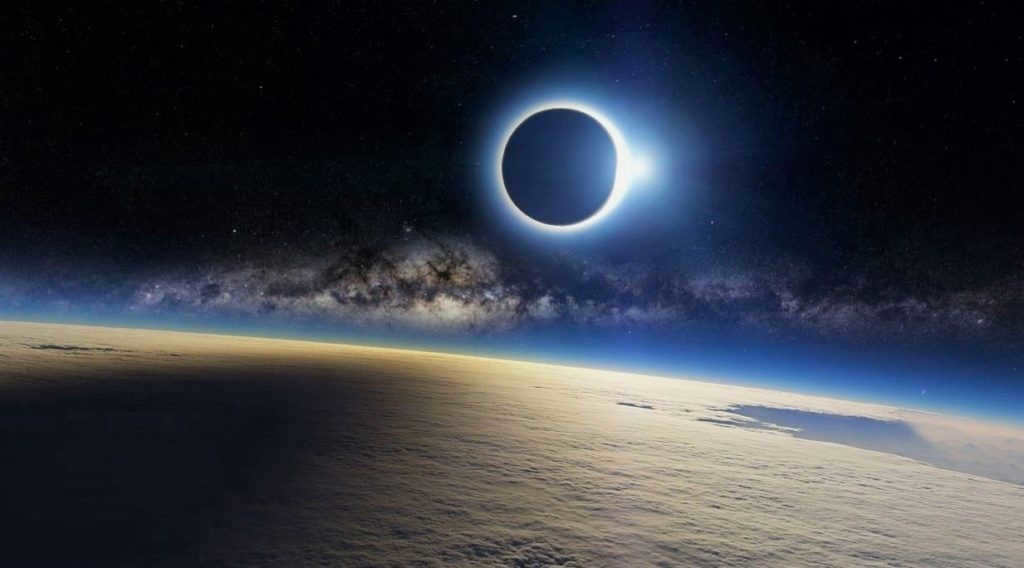

The initial solar eclipse will be of the total variety and will occur when the Moon is observed to be 105% the size of the Sun from the perspective of Earth. This event will completely obscure the Sun for a duration of 4 minutes and 28 seconds. It will be visible from Mexico, the United States, and Eastern Canada at 18:18 Moscow time.
The second eclipse is scheduled to take place on October 2 and will have a notably lengthy duration of 7 minutes and 25 seconds. It will be an annular eclipse, with the Sun being obscured by 93%. This event will be visible from Argentina and southern Chile, with the peak time expected to be at 18:46.
Solar eclipses in 2025
The initial solar eclipse is scheduled for March 29th at 10:48. It will be a partial eclipse with approximately 94% of the sun being obscured by a satellite. The ideal locations to witness this celestial event are in Europe, northern Russia, and western Africa.
The second solar eclipse will occur on September 21st at 19:43. Similarly, it will be a partial eclipse, however this time the sun will only be obscured by 85%. This phenomenon can be observed from the regions of New Zealand and Antarctica.
Solar eclipses on other celestial bodies
Given the presence of satellites on most planets in our solar system, it is logical to assume that eclipses can also occur on these celestial bodies. However, upon closer examination, it becomes evident that this phenomenon is only readily observable from Earth.
Mercury and Venus, for instance, lack satellites altogether, making it impossible to witness an eclipse from their surfaces. Similarly, the gas giants like Saturn, Jupiter, Uranus, and Neptune, despite having numerous satellites, do not possess a solid surface for shadows to fall upon, thus rendering the occurrence of eclipses impossible.

There are opportunities to witness some semblance of eclipses on Mars and Pluto. However, due to the small size of both satellites of the red planet, the Sun is not completely obscured, resulting in an annular eclipse with a stretch. On the other hand, Pluto and its companion Charon always face each other on the same side, making it possible to observe the phenomenon only from one hemisphere of the planet.
Did you know? Solar eclipses can be perfectly observed from either of Mars’ two satellites. The red planet regularly obscures the Sun, causing Deimos and Phobos to be hidden in its shadow.
It seems that Earth is the only planet with suitable conditions to regularly witness solar eclipses from different parts of the planet.
If you find any errors, please highlight the text and press Ctrl+Enter.
Solar eclipse – a kids’ guide to understanding the different phases and conditions of this fascinating celestial event. Explore a detailed diagram of the eclipse, learn about the precise positions of the Moon, Sun, and Earth in space, and discover the unique characteristics of total, partial, and annular eclipses. Find out how to safely observe this awe-inspiring phenomenon and be captivated by the wonders of the solar system.
For young children, it is important to understand the process of a solar eclipse. They should be aware that all objects in the solar system follow their own paths. On certain dates, the moon comes between the Earth and the sun, casting its shadow on a specific part of the Earth. The type of eclipse that occurs depends on the positions of these celestial bodies and can be total, partial, or annular. It is essential to teach children about the factors that contribute to each type of eclipse. The diagram below illustrates how an eclipse is formed and which type of solar eclipse is observed in a given scenario.
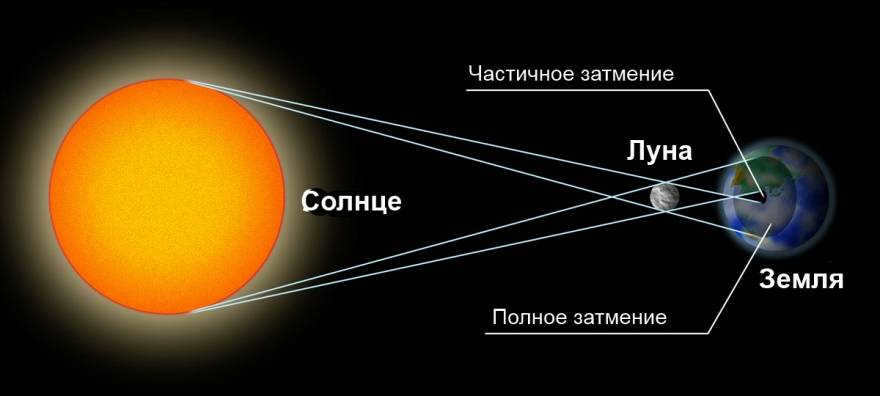
The configuration of a solar eclipse
Parents or educators in schools should begin by providing some context. The moon came into existence approximately 4.5 billion years ago. However, it was initially much closer until it started gradually moving away (at a rate of 4 centimeters per year). Currently, the Moon has receded so far that it aligns perfectly with the silhouette of the Sun (both objects appear to be the same size in the sky). Nevertheless, this alignment does not occur consistently.

To provide a comprehensive explanation to kids, it would be beneficial to explore the circumstances surrounding a solar eclipse and provide an example of a past occurrence, such as the one on February 26. This particular event was observable from Argentina, the South Atlantic, and certain regions of Africa. However, thanks to modern technology, individuals can now view solar eclipses from any location on Earth by using a computer.
The upcoming solar eclipse, which will transpire on August 21, will be visible from North America. This eclipse will be a total one and can be observed across various US states, extending from Oregon to Georgia.
Different Types of Solar Eclipses
When individuals witness a solar eclipse, they may not always be aware of the specific type they are observing. It is essential for children to learn about the four main variations: total, annular, partial, and hybrid.
In reality, we are incredibly fortunate when it comes to total solar eclipses. The sun’s diameter is 400 times larger than that of the moon. However, even young children understand that the Earth’s satellite is closer. Therefore, when their paths intersect, the distance becomes equal, allowing the moon to completely block out the solar disk. This phenomenon typically occurs once every 18 months.

The initial total solar eclipse of 2016 occurred in Norway and was captured in this photo.
The shadow is classified into two distinct types. The first is the umbral shadow, which completely blocks all sunlight and has a conical shape. Surrounding the umbral shadow is the penumbral shadow, which is lighter and takes on the shape of a funnel, allowing only part of the light to be blocked.
During a total eclipse, the Moon casts its shadow onto the Earth’s surface. It is fascinating to note that this shadow can travel approximately one-third of the Earth’s circumference in just a couple of hours. If one is fortunate enough to witness the eclipse in direct sunlight, they will observe the Sun’s disk transforming into a crescent shape.
During a total solar eclipse, there is a momentary occurrence when the Sun is completely obscured, allowing for the corona (the outer layer of the Sun’s atmosphere) to become visible. This phase typically lasts for a maximum of 7 minutes and 31 seconds, although it is more common for total eclipses to conclude before this time elapses.
On the other hand, a partial solar eclipse takes place when only a partial shadow, known as the penumbra, falls over a specific location. During this type of eclipse, a portion of the Sun is always visible, although which part is observable will depend on the specific circumstances.
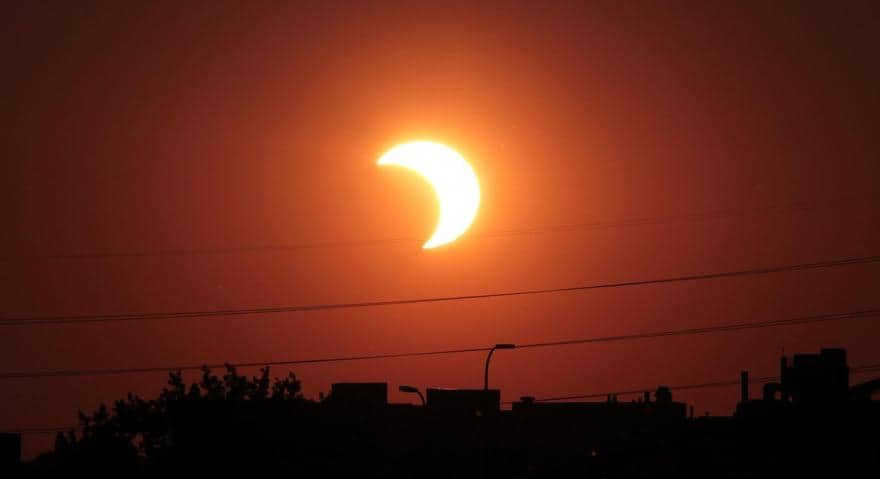

When the Moon hides just a portion of the Sun from viewers, it is called a partial solar eclipse.
The penumbra is usually located over the polar regions, while other areas nearby only witness a thin streak of sunlight obscured by the Moon. If you find yourself in the exact center of the eclipse, you will be able to see the portion covered by the Moon’s shadow. It’s important to educate children about this phenomenon because the closer they are to the center, the larger the eclipse will appear to them. For instance, if you are outside the path of the eclipse, you may observe the Sun shrinking into a crescent shape and then gradually returning to its normal appearance.
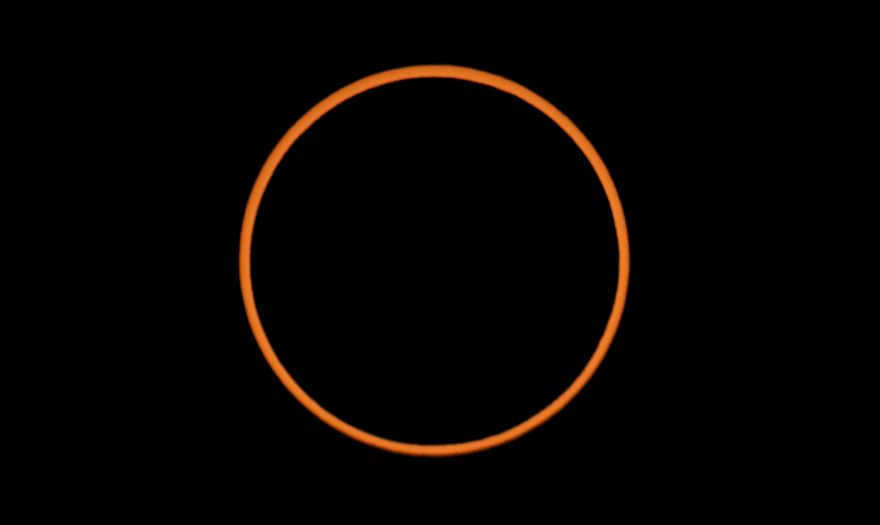
Photograph taken by Daniel Lynch showing an annular solar eclipse.
At times, it is often mistaken for a total solar eclipse since the Moon appears to occupy the entire central solar plane. However, the main distinction lies in the fact that our satellite is not close enough during an annular eclipse, resulting in it appearing smaller and not covering the entire disk. As a result, the shadow’s tip is not visible on Earth. If you happen to be at the exact center, you will witness a “ring of fire” encircling the Moon. Parents or school teachers can demonstrate this phenomenon by placing a coin on a bright flashlight.
These types of eclipses are also known as annular (A-T) eclipses. Such events occur when the Moon reaches its maximum distance, allowing its shadow to touch the surface of the Earth. Initially, the beginning of the eclipse resembles an annular type because the shadow tip has not yet reached the Earth. However, as the eclipse progresses, it becomes a complete eclipse when the shadow falls on the Earth’s roundness at its center, and then it returns to the ring type again.
Total, annular, and hybrid eclipses are referred to as “central” eclipses because they give the impression of a satellite crossing the solar line. This term is used to avoid confusion with partial eclipses. In terms of percentages, total eclipses account for 28%, partial eclipses for 35%, annular eclipses for 32%, and hybrid eclipses for 5%.
Forecasts for celestial events
Of course, it is vital for young individuals to understand that not every new moon will result in an eclipse. This is because the Moon’s orbit is tilted at an angle of 5 degrees relative to Earth, causing its shadow to usually pass above or below our planet. However, approximately twice a year (possibly five times), the new moon aligns perfectly with the Sun, resulting in an eclipse. This alignment point is known as the node. The type of eclipse, whether it be partial, central, total, annular, or hybrid, will depend on how close the Moon is to this node. Additionally, the specific positioning of the Earth, Moon, and Sun will also play a role in determining the formation of the eclipse.
Parents should be reminded that these occurrences are not random and can be predicted, allowing people to be prepared. There is a specific cycle known as the Saros cycle. Children may be surprised to learn that this cycle was actually calculated by ancient Chaldean astronomers 28 centuries ago. The term “saros” itself referred to the process of repetition and was equivalent to 18 years and 11⅓ days (though the number of days would vary in a leap year). At the end of each cycle, the Sun and Moon align with their previous positions. So what does this mean for a third? It represents the path of each eclipse, which gradually shifts westward in terms of longitude with each occurrence. For instance, the total eclipse on March 29, 2006, traveled across western and northern Africa before reaching southern Asia. On April 8, 2024, it will repeat but will cover northern Mexico, the central and eastern U.S., and the coastal provinces of Canada.
Secure Monitoring
As the eclipse draws nearer, the media is increasingly emphasizing the importance of taking precautions when observing the event. They strongly advise against looking directly at the eclipse due to the risk of blindness. This has led many people to view eclipses as potentially dangerous. However, this perception is not entirely accurate.
In reality, the Sun always poses a certain level of danger. It continuously emits invisible infrared rays that can harm our eyesight. Children may have experienced this firsthand when they have stared at the Sun for prolonged periods. Of course, most of us know better than to do that, but during an eclipse, we are naturally inclined to look up.
Fortunately, there are safe methods…

Utilizing specialized eyewear is an excellent option for safely viewing a solar eclipse
There is also an option to create a unique mirror with special perforations. It is a DIY project that requires a paper with a small hole to cover a mirror, which should be no larger than the size of your hand. To optimize the effect, position the mirror on a windowsill that receives direct sunlight from a window on the sunny side of the house. Adjust the angle so that the reflective side of the mirror reflects the sunlight onto a wall inside the house. This will result in the appearance of a circular image, resembling the face of the sun. To enhance visibility, increase the distance between the mirror and the wall. For every three meters of distance, the image becomes 3 cm more visible. It is important to experiment with the size of the hole, as a larger hole will make the image brighter but less clear, while a smaller hole will make it darker but more defined. Remember to cover other windows with curtains and keep the lights off in the room to create optimal darkness. Additionally, ensure that the mirror is flat and avoid looking directly at the reflection.
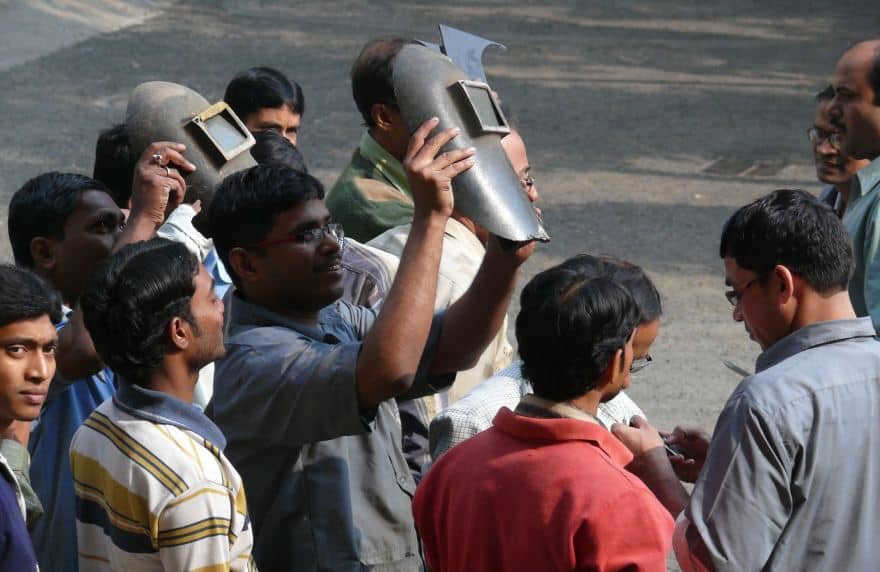

Another option for observation is to use 14 arc welding aluminum mylar. It can be bought at welding supply stores. It is recommended to verify its suitability prior to the event.
It is advisable to dispose of outdated camera film negatives, as well as black and white film (which does not contain silver), sunglasses, neutral density photographic filters, and polarizing filters. While these items may not allow much sunlight to pass through, it is important for youngsters to understand that they are not adequately shielding their eyes from excessive near-infrared radiation, which can result in retinal burns. It is a mistake to assume that lack of discomfort equates to safety while viewing.
Ancient Times and their Eclipses
A Children’s Guide to Understanding would not be complete without discussing the events of the past. The first documented accounts of eclipses date back 4000 years. According to Chinese mythology, eclipses were believed to be caused by a colossal dragon attempting to devour the Sun. To combat this mythical beast, the emperor’s court employed skilled astronomers who would shoot arrows into the sky, beat drums, and make loud noises in order to frighten away the monster.


The Incas were afraid that the lunar eclipse was caused by a jaguar attack on the moon. They tried to chase it away by making noise and beating their dogs to make them howl and bark.
This is described in the ancient Chinese book Shujing (Book of Documents). It recounts the story of two astronomers at court, Xi and Ho. They were found intoxicated before the eclipse began. The emperor was furious and ordered their execution by beheading. This event occurred on October 22, 2134 BC.
Eclipses are referenced in the Bible as well. An example can be found in the book of Amos 8:9: “I will create a sunset in the middle of the day and darken the earth during the brightest hours.” Scholars believe that this verse is referring to the eclipse that occurred in Nineveh on June 15, 763 BC.
A war could be halted by a solar eclipse
According to Herodotus, the Lydians and Medes were engaged in a 5-year war. As the war was about to enter its sixth year, Thales of Miletus, a Greek philosopher, predicted that there would soon come a time when day would turn into night. This prediction came true on May 17, 603 BC. The warriors interpreted this event as a warning from the gods and decided to make peace.
Undoubtedly, kids might be familiar with the phrase “terrified to the point of death”. As a matter of fact, this particular saying is based on a true event involving Emperor Louis of Bavaria, the son of Charlemagne. It was on May 5, A.D. 840, when he witnessed a complete solar eclipse that lasted for a remarkable 5 minutes. However, upon the Sun reappearing from behind the shadow, Louis was so astounded that he passed away from sheer terror!
Contemporary research
Scientists have conducted extensive research on our solar system in an attempt to comprehend the phenomenon of an eclipse. While obtaining information was challenging in the past due to the limitations of space exploration, significant knowledge was accumulated by the 18th century.
In order to observe the total solar eclipse on October 27, 1780, Professor Samuel Williams from Harvard University organized an expedition to Panebscot Bay, located in Maine. Despite the risks associated with entering enemy territory during the War of Independence, the British acknowledged the scientific significance of the expedition and allowed it to proceed without any political objections.
During a complete orbit, multiple vibrant crimson dots were visible encircling the dark disc of the orbiting object. These particular occurrences are known as solar prominences – scorching hydrogen abruptly erupting onto the surface of a celestial body. The occurrence was initially observed by Pierre Janssen, a French astronomer, on August 18, 1868. This discovery ultimately led to the identification of a novel element, which was subsequently named helium by other astronomers, namely J. Norman Lockyer and Edward Frankland, drawing from the Greek term “helios” meaning “sun”. However, helium was not officially recognized until 1895.
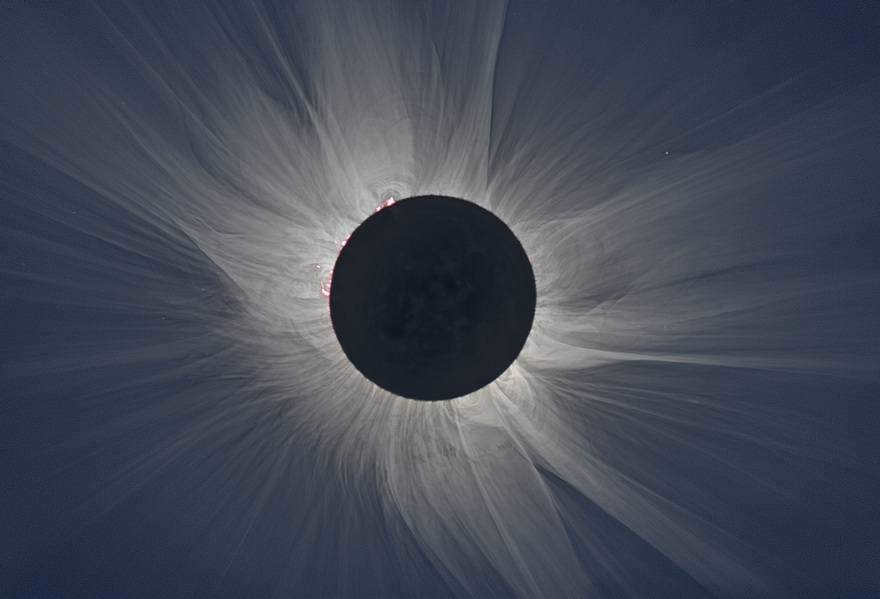

Scientists from various parts of the world employ a total solar eclipse as an opportunity to study the solar corona
A total eclipse is intriguing because it blocks sunlight, allowing for easier observation of the surrounding stars. It is in these circumstances that astronomers can test the general theory of relativity, which predicted that starlight would bend around the Sun and follow a straight path. To accomplish this, they compared two images of the same stars taken during the total eclipse on May 29, 1919, as well as in the afternoon.
While modern technology has advanced to the point where it can track other stars without the need for eclipses, there is still something truly special about witnessing a total eclipse. It is an event that is eagerly anticipated and should be experienced by everyone. If you are curious about the process and conditions that create a solar eclipse, our website offers a variety of resources to help you understand. We have a collection of photos, videos, and drawings, as well as interactive models that allow you to visualize and explore the characteristics of stars. Additionally, we have online telescopes that provide real-time observations of the Sun, and a 3D model of the solar system complete with all the planets, a detailed map of the Sun, and a surface view. Don’t forget to check our calendar pages to stay informed about upcoming solar eclipses.
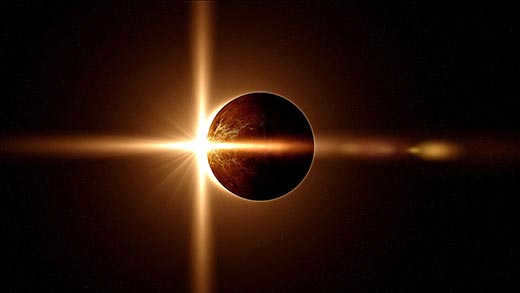
Back in ancient times, a solar eclipse would induce panic and irrational fear among our ancestors. Various civilizations held the belief that it was a sign of impending doom or the fury of the gods.
In modern times, science has advanced enough to unravel the mysteries behind this celestial phenomenon and uncover the underlying causes. So what exactly is a solar eclipse and why does it happen?
What is a solar eclipse?
A solar eclipse is a natural event that happens when the Moon obstructs the view of the Sun from observers. If the Sun is completely hidden, the Earth becomes dark and the stars become visible in the sky.
During this time, the temperature of the air decreases slightly, animals become agitated, certain plants fold their leaves, and birds stop their singing, startled by the sudden darkness.
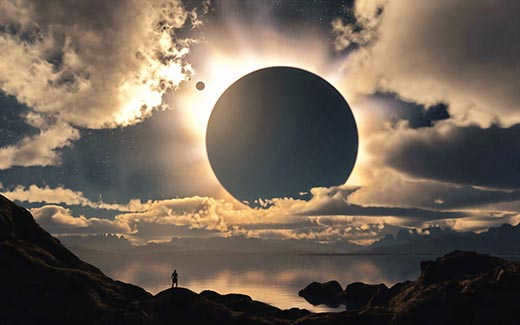
Solar eclipses occur when the Moon passes between the Sun and the Earth, blocking the sunlight and casting a shadow on the Earth’s surface. This phenomenon happens during the new moon phase, when the side of the Moon facing our planet is not illuminated by sunlight, creating the illusion of a black spot on the Sun.
Due to the Moon’s smaller diameter compared to the Earth, solar eclipses can only be observed from specific locations on the planet. The area of darkness, known as the umbra, has a maximum width of approximately 200 km. The total duration of the dark phase is relatively short, lasting only a few minutes. After this period, the Sun gradually emerges from behind the Moon, illuminating the Earth once again.
What causes a solar eclipse?
A solar eclipse is a rare and fascinating event that occurs when the Moon aligns perfectly between the Earth and the Sun. Despite the vast difference in size between the Sun and the Moon, their apparent sizes from Earth are nearly equal. This is because the Sun is much farther away from us compared to the Moon.
At certain times, the Moon appears larger than the Sun and completely blocks its light, creating a solar eclipse. These moments occur when the new moon occurs near the points where the Moon’s orbit intersects with the Sun’s orbit, known as lunar nodes.
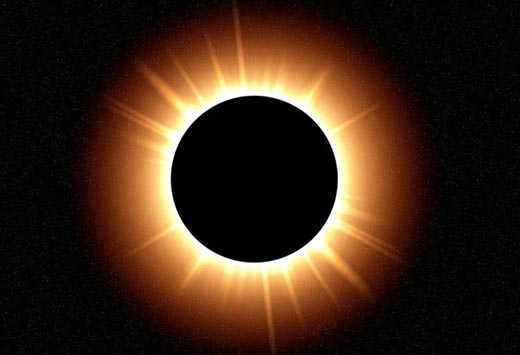
When astronauts are aboard the space station, they observe the solar eclipse as a lunar shadow casting itself upon certain parts of the Earth’s surface. This phenomenon takes the form of a converging cone and progresses across the globe at a velocity of approximately 1 kilometer per second.
When viewed from our planet, the Sun appears as a dark spot, surrounded by a corona – bright layers of the sun’s atmosphere that are not visible to the naked eye under normal circumstances.
What are the different types of solar eclipses?
There are two main types of solar eclipses: total eclipses and partial eclipses. During a total eclipse, the Moon completely covers the Sun, creating a narrow band of darkness for viewers on Earth.
Partial eclipses, on the other hand, occur when the Moon only partially covers the Sun. In these cases, observers are positioned outside of the shadowed band and may be up to 2000 km away. The sky does not darken as much during a partial eclipse, and the stars are still visible.
It is quite fascinating how an eclipse can appear as either an annular or total eclipse depending on its location on the planet. A hybrid eclipse, which allows the edges of the solar disk to be seen around the moon, while keeping the sky bright and devoid of stars and corona, is considered to be a rare occurrence.
What is the frequency of solar eclipses?
